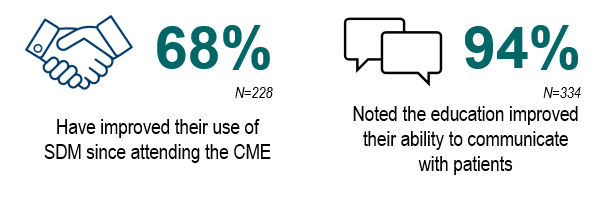Discordance among patients and providers regarding several aspects of healthcare is common. While the end goal of continuing education (CE) in the health professions is improved patient health, the inclusion of patients on the planning committees of CE programs is underutilized. Highlighted herein is evidence regarding the benefits of involving patients when planning CE programs.
Including Patient Planners in CE
For the purposes of this study, Vindico Medical Education defined a patient planner as “a patient identified [by faculty] who served on most activity planning calls and was present for the delivery of the CE” (either at the live event or recording or involved in the text writing around the activity). This participation differs from programs that included patients during the CE delivery, but they were not involved in the planning of the program. With this definition, Vindico held four in-person conferences in fall 2019 that featured a patient planner. Patient planners were tasked with spearheading the educational segments of topics like perception of care, quality of life, use of shared decision-making (SDM), stigma and effective communication strategies. Of importance, patient planners were treated as equals to all other program planners.
Assessment of Impact
Attendee perception of including a patient planner was assessed immediately after the education, utilizing a series of dichotomous assessment questions. Additionally, the impact of inclusion of a patient planner on practice patterns was assessed immediately after the education and again 30 days later.
Across specialties (internal medicine, rheumatology, neurology and gastroenterology), 90–94% of attendees noted that the activity provided patient perspectives that they had not previously considered. Additionally, on average, 94% noted that the segment helped to instill empathy for their patients, and 96% noted that inclusion of a patient in future relevant CE endeavors are needed.
Figure 1: Impact of Education on Healthcare Professionals’ Perceptions

At the 30-day follow-up, 68%, on average, of providers had improved their SDM practices. Specifically, 94% noted that the education improved their confidence in communicating with patients, and 84% reported that they now provide patients with appropriate educational resources.
Figure 2: Impact of Education on Patient-centered Care

From the perspective of the patient planner, “There is always such a hunger and passion to hear directly from the patient … Knowing that my presentations may start to plant those seeds of confidence makes this an honor that the clinicians and I would arguably hope to create…”
Discussion
Continuing medical education serves to maintain, develop or increase the knowledge, skills and clinical performance of healthcare professionals. Although delivered in learner-centered formats, the increased importance of patient-centered care and SDM requires the introduction of novel educational approaches. Our study demonstrated the benefits of including patient planners in CE activities for instilling empathy, improving communication and streamlining the use of SDM in practice.
Just as not all CE initiatives are designed to target interprofessional audiences, not all CE would benefit from a patient planner. For example, programs that are designed to address clinical guideline updates or review data from recent studies may not be enhanced by patient input. However, programs that are more comprehensive and focused on multiple aspects of the care of patients, particularly those addressing chronic conditions, are ideally suited for patient planner involvement.
Careful selection of the patient planner is a critical success factor. In our experience, it is best to engage faculty in the selection of a patient who will be vocal, influential and a dynamic speaker. Patients who are actively involved in advocacy groups and/or active on social media typically have a broader mindset, representing not only their own personal experiences but those of peers impacted by the same condition as well.
While the data discussed here is derived from feedback from live programs only, the approach of using patient planners can be adopted for web CE programs as well. Patient planners have been particularly useful in the development of case-based programs, clinical simulations or CE activities that address the patient journey and/or care coordination.
Conclusion
Including a patient on the planning committees of CE initiatives has numerous benefits on CE outcomes, with no additional burden to overall program development and execution. Specifically, it provides healthcare professionals with a perspective that had not been previously considered, which translates to increased patient empathy and more effective communication. Collectively, these benefits can serve to strengthen the patient-provider therapeutic alliance toward improved healthcare delivery.
 Katie Robinson, PhD, CHCP, is the senior director, outcomes and analytics, for Vindico Medical Education.
Katie Robinson, PhD, CHCP, is the senior director, outcomes and analytics, for Vindico Medical Education.